I spent the vast majority of my junior high free time in front of a scratchy television connected to a Nintendo Entertainment System (NES) console. (Try not to act too surprised.) Many of the more involved Nintendo games either had battery-backed RAM on the cartridge PCB for saving games or employed a password system. The game would issue a password at various junctures in the game that you were expected to copy down accurately so that you could resume your game at a later time. Password lengths were commensurate with the complexity of the game and the amount of information required to represent a game’s state. For example, some games obviously had a table of plaintext 4- or 5-character passwords since the only information being saved was which of the game’s 8 levels the player has just passed. On the other end of the spectrum, the most complex password system I ever encountered was for Wall Street Kid, the groundbreaking stock market sim for the NES. It was a variable length password (at least 50 characters was nominal, if memory serves) with just about every letter of the English alphabet, upper and lower case, numbers, and various other symbols. I don’t think I ever successfully copied down a password for that game.
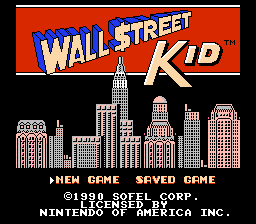
Wall Street Kid
Other games were a little more innovative and used pictorial passwords. Some Mega Man and Castlevania games used this.
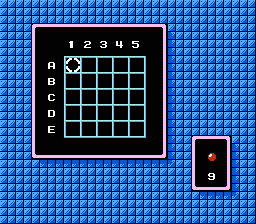 Mega Man II password screen |
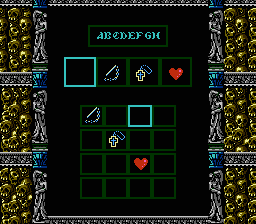 Castlevania III: Dracula’s Curse password screen |
I thought Mega Man’s dots worked well. A problem with Castlevania’s system is that I would write letters inside the graph cells and would always need to record a legend next to the graph.
It is useful to note that games from the same company would often share password systems, or at least formats. For example, Metroid and Kid Icarus both had a password in the format of 4 strings of 6 characters (which allowed for some curious English-language special passwords such as ‘ICARUS FIGHTS MEDUSA ANGELS’).
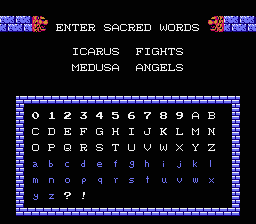
Kid Icarus password screen
As a nerd in my formative years I was curious about how these password systems operated, especially after Nintendo Power magazine published the complete guide to how 1943’s password system worked (the issue with Duck Tales on the cover). I actually tried to discern some details about a medium complexity password system from Solar Jetman simply by trial and error, observation and note-taking. Naturally, I didn’t get far, but I realized recently that I still have my notes from 15 years ago (this is in contrast to notes taken during countless years of academia, to which I never, ever refer). Solar Jetman had a 12-character password in which I was able to observe some simple perturbations.
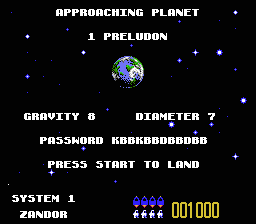
Solar Jetman, first planet with associated password
According to my brief and largely incomprehensible notes from 1.5 decades previous, the password for planet Mexomorf with all the same starting parameters (regular pod capsule, $1000, and something referred to as “41”) has 3 changed characters. Eventually, I came to the conclusion that the people charged with creating these password systems were super-geniuses.
Armed with some computer science knowledge and general information coding theory, I now know a little better. The first thing that occurs to me now when analyzing these passwords is recognizing how much information is actually encoded in a password. For example, the Metroid/Kid Icarus password system allowed for 64 unique symbols. log264 = 6. Thus, each of the 24 characters encodes 6 bits for a total of 144 bits of information. Passwords as found in Solar Jetman do not fall into the same, neat, power-of-2 pattern as they can use any of the 26 English alphabetic letters for their 12 password characters.
According to my notes, another title with an obscenely long, and variable length, password was for an incredibly interesting action/adventure/role-playing game named The Magic of Scheherazade. Some games really should have had battery-backed RAM. This game’s passwords were between 43 and 45 characters.
45 characters? That’s nothing. To transfer stats between Golden Sun and Golden Sun: The Lost Age (both games for the GameBoy Advance) you can choose between three passwords that determine which stats will get transfered. The gold password (transfer everything) is 260 characters long!!
There’s also an easier way, connecting two GBAs via link cable, but if you don’t have two GBAs…
260?! That’s insane! But, as you mentioned, it’s a hack with a better alternative solution. It makes me wonder how long a password would have been for a game like, say, The Legend of Zelda that saves its data with battery-backed RAM.
How large was the character set? Did it contain potentially colliding characters (0 vs O, 1 vs l vs I)?
Yes, there are colliding characters, it’s numbers, the entire alphabet – case sensitive!, and even characters such as #+=&.
But it’s not that bad, the actual savegames are in battery-backed ram, the password is only needed if you want to transfer stats from the first game to the sequel, so it’s a one-time deal.
There’s also the silver (60 character) and the bronze (16 character) password. It’s a matter of how much of the personal touch you want when playing the sequel … or how crazy you are :)
I still remember my research of passwords from NES’ Prince of Persia and (woohoo!) Metal Gear games. Although, MGS has pretty huge passwords, it was surprisingly simple scheme. Same for PoP – shorter passwords, digits only and my first bruteforced working code was something like 1111111112 :)